Saturday, November 05, 2005
Silvered Æ antoninianus, Gallienus, Mediolanum, Göbl 1286f

IMP GALLIENVS AVG, Radiate head right| SALVS AVG, Aesculapius standing left, chest bared, leaning right hand on snake-entwined staff. P in exergue.
A popular reverse at Milan, issued with a variety of obverse legends, busts, and officina marks. Health was, it seems, of unusually great concern in this city. Mosquitoes, I betcha.
Friday, November 04, 2005
Æ21, Nicaea & Byzantium in Bithynia, Gallienus, ...
SNG Copenhagen 531 (Thrace)
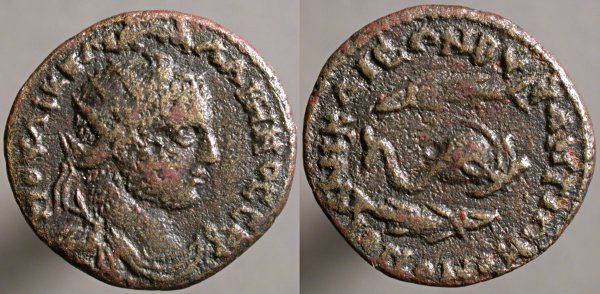
ΠOY ΛIK EΓ ΓAΛΛIHNOC CEB, Radiate draped cuirassed bust right | NIKAIEΩN BYZANTIΩN OMONOIA, Dolphin swimming right, two tunny-fish swimming to the left above and to the right below.
Tunny was an older name for tuna, still used mainly for the “Little Tunny”, Euthynnus alletteratus (and for the submarine USS Tunny, SSN 682.)

ΠOY ΛIK EΓ ΓAΛΛIHNOC CEB, Radiate draped cuirassed bust right | NIKAIEΩN BYZANTIΩN OMONOIA, Dolphin swimming right, two tunny-fish swimming to the left above and to the right below.
Tunny was an older name for tuna, still used mainly for the “Little Tunny”, Euthynnus alletteratus (and for the submarine USS Tunny, SSN 682.)
Thursday, November 03, 2005
Billon antoninianus, Gallienus, Viminacium, Göbl 805o

IMP GALLIENVS P AVG, Radiate draped cuirassed bust right | CONCORDIAE MILITVM, Concordia standing left holding patera in right hand and cornucopia with left.
Göbl shows this martial reverse for Gallienus only, but while Valerian was still alive. It was a pleasant surprise to find it for Valerian, apparently otherwise unknown.
Update: A wise emailer has pointed out that this is for Gallienus, as can be read, with a bit of effort, from the obverse legend. The face may look more like Valerian, but Gallienus is named.
Wednesday, November 02, 2005
Æ13, Laodiceia ad Mare in Syria, Seleukis and Pieria, quasi-autonomous, 1st C. BCE, Lindgren & Kovacs 2067
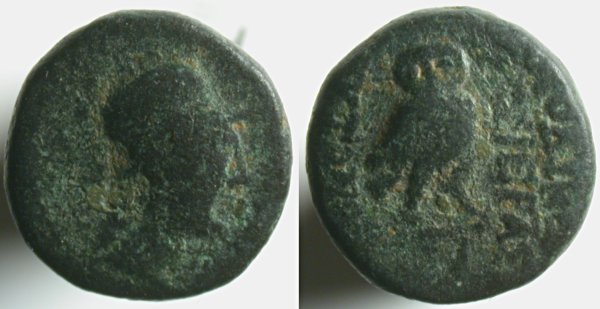
Helmeted bust of Athena right | Owl standing right, head facing, [ΛA]OΔIK[EΩN] / [TH]Σ IEPAΣ right, [KAI AY]TON[OMOY] left.
The owl as a symbol of power, unlike yesterday's eagle, is pretty much a thing of the past.
Tuesday, November 01, 2005
Æ21, Acmoneia in Phrygia, quasi-autonomous, BMC Phrygia pg. 7, 24
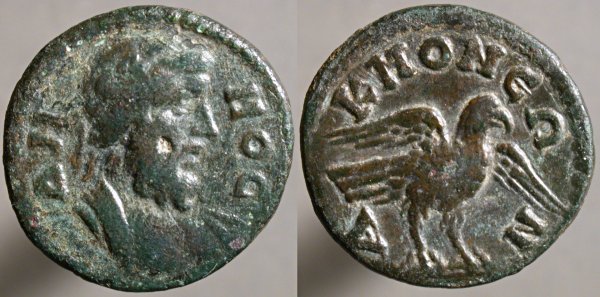
ΔH_MOC, Diademed bearded draped bust of Demos right | A_KMONEΩ_N, Eagle standing right on fulmen; wings open.
The eagle as a symbol of power preceeded the Romans and continues to this day.
Monday, October 31, 2005
Æ antoninianus, Gallienus, barbarous
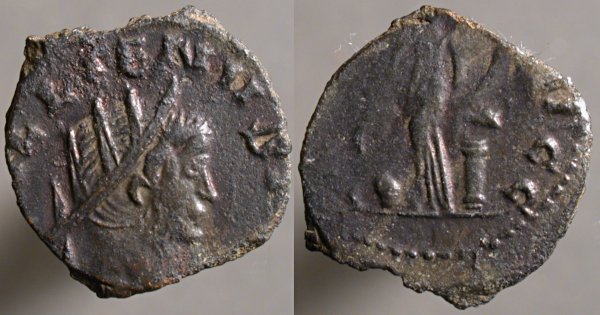
[...]LLIENVS[...], Radiate head right | L[...]VGG, Providentia standing left, with right hand pointing scepter at globe at feet left, holding cornucopia with right hand.
It's uncertain to what extent these were merely counterfeits (they're not very convincing. so could have only fooled people where they were unfamiliar with the real thing) and to what extent they substituted for absent official coins without anyone being fooled.
While Tetricus and his son, also named Tetricus, are the most commonly-seen emperors on the coins, other emperors of the period do occur, as here. This may roughly mirror the distribution seen on official coins where these were produced, which may well have been Britain in the mid-third Century.
Sunday, October 30, 2005
“a wound even Aescalapius could not cure”
A nice bronze of Diadumenian from Nicopolis in Moesia Inferior on The Shekel - Coins, Law and Commentary.
Æ28, Heliopolis in Coele-Syria, Gallienus?, SNG Copenhagen 441..
...var
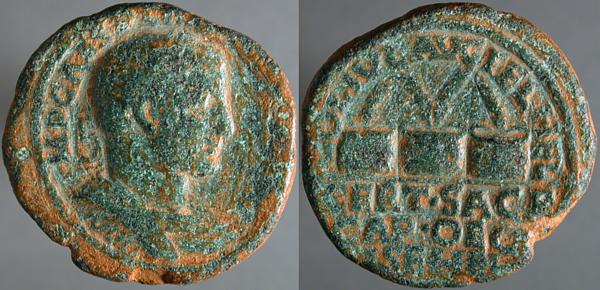
IMP CAES ?[P LIC GALLIENVS AVG]?, Laureate cuirassed bust right | COL IVL AVG FEL HELO, Three prize crowns, two palms protruding from the center, one each from the other two. CERT·SACR / CAP·OEC[V?] / ISE·HEL in three lines in exergue.
While the obverse legend is unreadable, and thus the emperor uncertain, the bust looks to me more like the coins of Gallienus than it does like those of his father. In truth, it's a closer call than I like.
-->

IMP CAES ?[P LIC GALLIENVS AVG]?, Laureate cuirassed bust right | COL IVL AVG FEL HELO, Three prize crowns, two palms protruding from the center, one each from the other two. CERT·SACR / CAP·OEC[V?] / ISE·HEL in three lines in exergue.
While the obverse legend is unreadable, and thus the emperor uncertain, the bust looks to me more like the coins of Gallienus than it does like those of his father. In truth, it's a closer call than I like.

